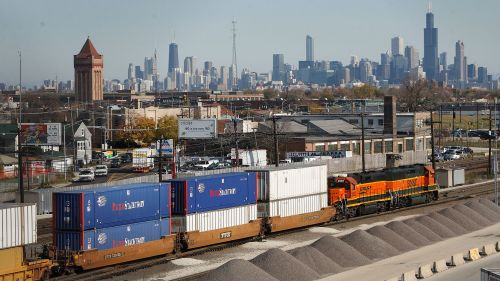Global Engagement Key Driver of Midwest Prosperity

For the Midwest to thrive in the global economy, it needs to open its doors to the world, not shut it out.
The Midwest
The Midwest was America’s first frontier, then the foundation of the country’s agricultural and industrial might. It was the birthplace of great industries and a mecca for migrants seeking a better life and new economic opportunity. As the region forged America’s middle class, much of its success resulted from robust global engagement through trade, immigration, and partnerships.
Today, too many voices in the region are turning their back to the world, advancing nativist and isolationist sentiments and policies. For the Midwest to thrive in the global economy, it needs to open its doors to the world, not shut it out. Midwest communities thrive when they support climate action agendas, such as the Paris Agreement, increase global trade, and welcome immigrants.
The Midwest faced a similar wave of isolationism and nativism driven by the First World War and the seismic economic dislocations of the Great Depression in the early twentieth century. But rather than succumb to these trends, the region’s business and labor leaders looked outward and crafted an affirmative and engaged economic and social response to a changing world. It led to a period of unrivaled US economic prosperity that shaped the international order, with an outsized role on the part of the Midwest and its dominant industrial, manufacturing, and agricultural sectors.
However, the Midwest's industrial might has diminished over the past 40 years. Revolutions in communications, transportation, and technology have shrunk the planet and reshaped the region’s mighty manufacturing base and, in turn, dissipated employment and populations in many Midwestern communities. Many cities and towns across the region are making an uneven transition from this industrial era to the new innovation-based, technology-driven, global knowledge economy.
This uneven adaptation of the Midwest’s communities and economy played out in the 2016 presidential election when uncertainties around a changing world and economic prospects for the future propelled Donald Trump to the presidency. As many Midwesterners’ economic and social anxieties spilled into the political sphere, it gave fuel to a new national round of protectionism and nativism, encouraged by the current administration.
But many Midwest communities have turned an economic corner and are thriving. Those that leveraged their great assets—innovative global companies, leading colleges and universities, historical anchor institutions, quality of place attributes—and opened doors to newcomers have found success in a changed economy.
Economic and social engagement with the world is a key part of these "winning" community strategies. To rebut arguments by those who would disengage from the world and international economy, we need to examine the economic performance and prosperity of Midwest communities relative to three strong proxies for global engagement: Climate action, international trade, and immigration.
These include those communities that:
- Make a purposeful commitment to fight climate change through participation in the Paris Climate Agreement that the Trump administration seeks to abrogate
- Have attracted a greater share of foreign-born residents through intentional and strategic immigrant welcoming policies
- Are disproportionately engaged and reliant on global commerce and trade through a higher relative share of exports
By examining the economic strength of Midwest communities in relation to these proxies for global engagement, we can see how global engagement economically benefits the Midwest.
Climate Action
Of the three proxies, there is a direct correlation between relative economic prosperity and the communities committed to tackling climate change. In the nine-state Midwest, from the eastern Great Lakes to Missouri and Iowa, roughly 15 percent of all counties are home to relatively prosperous citizens (“high-income”), where the median county income of residents is above their state’s median income. As seen in Table 1, 63 percent of these high-income counties are home to communities that have pledged to uphold the standards laid out in the Paris Agreement, through the We Are Still In campaign. Moreover, of all the Midwestern counties that are committed to the Paris Agreement, approximately 47 percent are high-income, a much higher rate than all Midwest counties, illustrating that those communities dedicated to global cooperation and standards for climate change reduction strategies also have the most robust local economies.
Table 1: Midwest High-Income Counties and the Paris Agreement
| Paris Agreement | ||||
|---|---|---|---|---|
| Total Counties | High-Income Counties | High-Income Counties Committed | % of High-Income Counties Committed | |
| Illinois | 102 | 13 | 10 | 77% |
| Indiana | 92 | 18 | 11 | 61% |
| Iowa | 99 | 22 | 5 | 23% |
| Michigan | 83 | 15 | 10 | 67% |
| Minnesota | 87 | 8 | 6 | 75% |
| Missouri | 114 | 7 | 7 | 100% |
| Ohio | 88 | 19 | 14 | 74% |
| Pennsylvania (western counties only) | 36 | 6 | 4 | 67% |
| Wisconsin | 72 | 11 | 8 | 73% |
| Midwest Total | 773 | 119 | 75 | 63% |
Welcoming Communities
There is also a connection between welcoming immigrants and a community’s economic growth. Thirty-seven percent of Midwest metro population growth has come from immigrants over the past 15 years. When the United States restricted immigration in the 1920s, the decline in total numbers of immigrants correlated with population stagnation and decline throughout the Midwest.
Research has also found that “the presence of immigrants led to increased economic growth.” Low-skilled immigrants play key roles as farm and meat-packing workers in rural counties and help keep the hospitality sector thriving, while in other communities immigrants tend to be engineers, doctors and nurses, and IT specialists. Immigrants start businesses at a higher rate than US-born individuals. And in Michigan, several studies have shown that immigrants to Michigan are better educated than the domestic population.
As Table 2 demonstrates, of the six Michigan counties with a higher share of immigrants (“high-immigrant”) than the state average, four are also among Michigan’s high-income counties. Overall, immigrant populations are made up of greater shares of individuals with a less than a high school diploma than the native-born population, but also a greater share of those with a bachelors or professional degree. Both of these immigrant groups meet critical Midwest labor market needs. Many communities, such as the Welcoming Economies Global Network, a project of Welcoming America and Global Detroit, are exploring how to maximize economic dynamism with immigrant populations.
Table 2: Michigan High-Income/High-Immigrant Counties
| Michigan | |
|---|---|
| Total Counties | 83 |
| High-Income Counties | 15 |
| High-Immigrant Counties | 6 |
| High-Immigrant/High-Income | 4 |
| High-Immigrant/Not High-Income | 2 |
| State Foreign Born Average | 6.40% |
Trade
There are many communities in the Midwest that are export-dependent, including numerous rural, agricultural counties that rely on foreign markets, as well as more urbanized metros with advanced products and services. While other Midwest communities do not have an industry or product mix that is engaged in global trade, the Midwest overall punches above its weight, accounting for 26 percent of the United States’ export-derived GDP.
On balance, being engaged in global trade appears to help, not hurt Midwestern communities. More than half (51 percent) of the high-income counties in the Midwest export more than their state average; Moreover, although high-income counties account for only 15 percent of the region’s 700-plus counties, they account for almost half (45 percent) of Midwest counties that are above average exporters. Furthermore, the number of Fortune 500 companies headquartered in the Midwest make it vital that the region remain globally engaged on trade.
Given current threats of pullback from the international order, and disentangling from mutually beneficial trade, environmental, and migration regimes, the Midwest must once again develop and make an affirmative, outward-oriented vision for its future. Regional leaders must reject trends towards disengagement with the world, nativism, and protectionism, but also map out a better, brighter path. They need to help guide the region in forging the supportive policies and economically and socially positive global engagements that will ensure success in the world and economy of today and tomorrow.
Notes and acknowledgements
Jack Farrell of the University of Michigan contributed to this piece.
Data for both tables was sourced from the US Census Bureau.
International trade data by county can be found through the International Trade Administration, US Department of Commerce; Metropolitan Statistical Area (MSA) export totals are divided equally across each MSA county.

